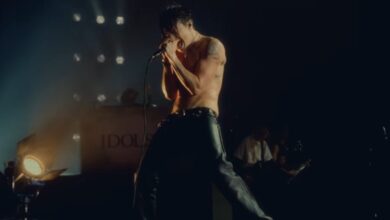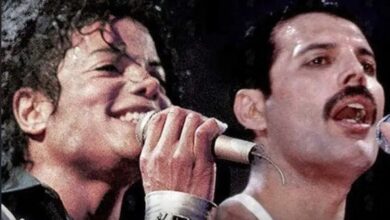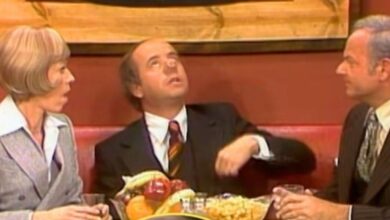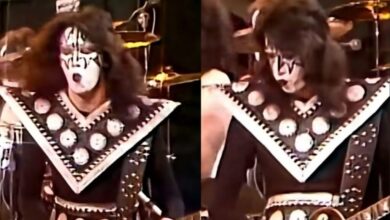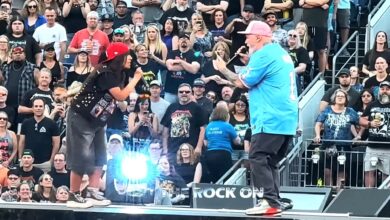Metallica Reigned Supreme with a Thunderous “King Nothing” at Adelaide Oval 2025
By the time the sun slipped behind Adelaide’s skyline on November 5, 2025, it felt less like a regular Wednesday and more like a civic holiday dedicated to distortion. After more than a decade without a full-scale Metallica show in South Australia, fans poured toward Adelaide Oval from every direction: along the riverbank, over the footbridge, down side streets packed with ride-shares and buses. You could spot generations at a glance—parents in faded Ride the Lightning shirts walking beside teenagers in fresh 72 Seasons hoodies—everyone buzzing with the same nervy excitement. Inside the stadium, the giant circular M72 stage sat in the middle of the pitch like an alien landing pad, ringed by four towering microphone towers and massive screens that promised no one would miss a single grimace, pick stroke, or drum hit once the main event began.
Well before Metallica stepped out, the mood inside Adelaide Oval had shifted from anticipation to full-throttle party. Suicidal Tendencies hit first, bringing a wave of old-school crossover chaos that sent the early general-admission crowd into motion, circle pits forming and dissolving as security kept a close but amused eye on the frenzy. Not long after, Evanescence took things in a darker, more cinematic direction, Amy Lee’s voice soaring up into the stands as dusk settled over the stadium. Their set threaded piano-driven drama with thick guitars, a perfect tonal bridge between punky mayhem and classic metal spectacle. By the time Evanescence wrapped and the changeover crew rolled gear on and off the circular stage, the stands were almost full, the concourses choked with last-minute merch hunters and fans clutching plastic cups as if they were sacred relics.
Anyone who has ever seen Metallica knew what was coming next, but that didn’t make it any less thrilling. The stadium lights dimmed to a low glow and the opening strains of Ennio Morricone’s “The Ecstasy of Gold” washed over the crowd, accompanied by the familiar imagery from The Good, the Bad and the Ugly on the wraparound screens. People whistled, cheered, and sang along as if it were already the first song of the set. When the band finally strode out—James Hetfield, Lars Ulrich, Kirk Hammett, and Robert Trujillo taking up positions at different points of the circular stage—the roar from 50,000 people was almost physical. They dove straight into Creeping Death, then For Whom the Bell Tolls and Leper Messiah, a punishing run of ‘80s material that reminded everyone exactly where this band came from. Just as the crowd caught its breath, James stepped to the mic with that familiar grin and teased the next song with a simple question: “You like the nineties, Adelaide?”
That was the cue for King Nothing to make its entrance, and the response was immediate. As soon as the opening bass line slithered out of the PA and Kirk’s thick, detuned riff locked in, tens of thousands of faces lit up with recognition, like a switch had been thrown. It’s one of those songs that lives in muscle memory for anyone who grew up with Load and Reload spinning in their bedroom or car, and you could see it in the way people moved—older fans with that “finally!” look on their faces, younger ones surprised by how heavy the track sounded live. The shift from the icy, staccato intro into the full groove felt like a gear dropping in a giant machine, the whole stadium lurching forward together.
Live, King Nothing is less about speed and more about weight, and in Adelaide it landed like a wrecking ball. James dug into his rhythm parts with that famous down-picking right hand, the guitars tuned low enough to make each chord feel like it was crawling out of the earth. Lars sat deep in the pocket, favoring a thick, almost swaggering drum feel over sheer aggression, snapping the snare just behind the beat for extra chew. Robert’s bass tone was all growl and rumble, filling the spaces between riffs so thoroughly that it felt like the song was wrapping itself around the stadium. Over the top, James delivered the verses with a venom that belied the song’s age, spitting lines about greed and ego with the conviction of someone who has seen every side of fame.
What really set this performance apart, though, was the crowd’s reaction to every “Where’s your crown, King Nothing?” in the chorus. On the big screens, you could watch that line ripple around the oval in real time: first the people crushed against the rail, then the middle GA pack, then the stands, all shouting it back at the band like a shared accusation. During the pre-chorus, when the music drops slightly and the tension builds, the sound of 50,000 voices shouting “Then it all crashes down!” created a strange, collective catharsis. For a few minutes, the line between performers and audience blurred completely; the song became less a performance and more a massive, stadium-wide venting session disguised as a groove metal anthem.
Visually, King Nothing turned the M72 stage into a living comic book panel. The lighting rig drenched the stadium in toxic greens and sickly golds, picking up the crown imagery that has always surrounded the song. On the wraparound screens, live close-ups of the band were intercut with stark graphic treatments—grainy black-and-white shots of James’ face half in shadow, slow-motion footage of Robert’s fingers hammering the strings, Lars’ drumsticks captured mid-air like twin blades. During the chorus, banks of moving lights swept across the crowd in arcs, momentarily blinding sections of the audience before plunging them back into darkness, as if the song itself were interrogating the stadium.
Down on the field, the song created its own sort of controlled chaos. The general-admission sections erupted into multiple pockets of movement: some fans simply headbanged in place, others formed looser, bouncing pits that flared up during the riff and relaxed between lines. In one corner of GA, a scuffle briefly broke out—a handful of overexcited fans jostling too hard and tempers flaring—but security moved fast, pulling people out and diffusing the situation while the band thundered on, seemingly unfazed. If anything, the slightly rough edges in the crowd energy only underscored how intensely people were living inside the moment. When you put a song this heavy, this sarcastic, and this catchy in front of tens of thousands of amped-up people, something is bound to overflow.
What makes King Nothing such a compelling choice in 2025 is how its subject matter has aged. Written in the mid-90s as a sneering take on hollow ambition and the emptiness at the top, it feels almost more relevant in the era of social media fame and disposable celebrity. Hearing James snarl “Wish I might, wish I may, you might never see the light of day” across a stadium lit by thousands of phone screens added an extra layer of irony. Listening to that many people chant “Where’s your crown, King Nothing?” together, you got the sense that the crowd wasn’t just shouting about some fictional narcissist; they were exorcising frustrations with every self-appointed “king” who has strutted across their screens over the last decade.
Musically, placing King Nothing early in the set turned out to be a clever piece of pacing. Coming off three high-velocity classics, the song shifted the show’s energy from frantic sprint to muscular stomp, giving the crowd something massive to lean into without actually slowing the momentum. After King Nothing, the band slid into Fade to Black and Fuel, building an arc that moved from introspective and epic to fast and combustible. Later in the night, they threaded in newer material and deep cuts, but it was that early stretch that anchored the show’s personality: a mix of old-school thrash, moody ‘90s heaviness, and modern pyrotechnic precision that proved Metallica’s catalog is still evolving onstage rather than calcifying into a greatest-hits jukebox.
The rest of the night only deepened that impression. Between songs, James kept up a loose, funny rapport with the crowd, joking about the band’s age one moment and then rallying everyone into a roar the next. Kirk and Rob had their “doodle” segment, jamming on riffs that nodded toward local flavors before the band dove back into full songs. Later in the main set and the encore, stadium-destroying staples like One, Nothing Else Matters, Sad But True, and Enter Sandman made their expected appearances, each one greeted like an old friend. Yet, when fans talked about highlights afterward, King Nothing got mentioned again and again as the moment where the show made a sharp left turn into something uniquely 90s, uniquely sardonic, and uniquely satisfying.
Adelaide also lucked out with the kind of local surprise that only happens when a band is fully engaged with where they’re playing. Later in the show, Metallica tipped their hat to Australian rock history by ripping into a cover of The Angels’ “Am I Ever Gonna See Your Face Again,” setting off the legendary Aussie crowd response that has echoed through pubs and festivals for decades. You could see James and the guys grinning as the chant rolled around Adelaide Oval, clearly delighted by the call-and-response culture they’d stepped into. Earlier in the tour, they’d nodded to John Butler Trio in Perth; in Adelaide, fusing The Angels’ anthem into their set made the night feel like it belonged to the city as much as to the band.
Out in the stands and on social media, you could feel the aftershocks almost immediately. Metallica fans posted grainy clips of King Nothing from every angle: close-ups from the Snake Pit, wide shots from the top tiers, shaky footage from the middle of the crush where the camera bounced in time with the riff. In fan groups and comment threads, people raved about how huge the song sounded, some admitting they’d never fully appreciated it on record until they felt that riff roll through a stadium. Others swapped stories about the last time they’d heard it live years ago, marveling at how tight and massive it still felt in 2025, with the band four decades into their career and still swinging like they had something to prove.
There was also a strong sense that King Nothing had become a sort of secret handshake among fans who cherish Metallica’s 90s era. While the Black Album cuts and the classic thrash songs will always draw the loudest instant recognition, King Nothing occupies a special niche: catchy enough for casual listeners, heavy enough for the diehards, and lyrically sharp enough to reward closer attention. In Adelaide, you could see that in real time. Some people near the back only really lit up once the chorus hit, while others up front were already shouting along to every verse, every pre-chorus, and every sneer in James’ delivery. It was the kind of performance that quietly reshuffles a song’s status in the live hierarchy.
By the time the last fireworks fizzled out above Adelaide Oval and the house lights came up, the energy that King Nothing had unleashed still hung in the air. As the mass of bodies slowly funneled out through gates and onto city streets, you could overhear fragments of the night being replayed in conversation: arguments over the best song in the set, disbelief at how strong James’ voice still sounded, laughter about the brief fight in GA that security squashed, and, over and over, people half-singing “Where’s your crown, King Nothing?” as they disappeared into the night. Phones came back out as soon as signals returned, with fans already hunting for the cleanest video of that performance to save, share, and relive.
In the days that followed, more polished uploads from better vantage points began circulating, including crisp 4K footage where you can see every bead of sweat and hear every cymbal decay. Watching those clips, it’s easy to understand why that particular rendition of King Nothing has lodged itself in people’s heads. The camera captures James stalking the stage with that unmistakable mix of menace and mischief, Lars pounding the groove with a grin that borders on a snarl, Kirk flicking his hair back between licks, and Robert whipping his bass around like it weighs nothing. But just as importantly, it captures Adelaide itself—tens of thousands of people moving, shouting, and laughing together, briefly united in telling every false king and paper crown exactly where they stand.
For Adelaide, November 5, 2025 will be remembered as the night Metallica finally came back and proved that time has only sharpened their edge. For Metallica, it was another chapter in a world tour full of milestones and unexpected moments. And for King Nothing, it felt like a coronation of its own kind, a reminder that beyond the obvious singles and the legendary early albums, there are songs in their catalog that still have room to grow bigger, heavier, and more meaningful onstage. Under the lights of Adelaide Oval, with 50,000 voices roaring the chorus into the dark, King Nothing didn’t feel like a deep cut or a nostalgic detour. It felt like a crown jewel.
